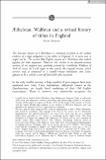Files in this item
Æthelstan, Wulfstan and a revised history of tithes in England
Item metadata
| dc.contributor.author | Ivarsen, Ingrid | |
| dc.date.accessioned | 2021-04-28T11:30:02Z | |
| dc.date.available | 2021-04-28T11:30:02Z | |
| dc.date.issued | 2021-04-28 | |
| dc.identifier | 273444465 | |
| dc.identifier | 3c50b75a-82d4-44f1-a65e-d005984f964f | |
| dc.identifier | 85105014859 | |
| dc.identifier.citation | Ivarsen , I 2021 , ' Æthelstan, Wulfstan and a revised history of tithes in England ' , Early Medieval Europe , vol. 29 , no. 2 , pp. 225-252 . https://doi.org/10.1111/emed.12473 | en |
| dc.identifier.issn | 0963-9462 | |
| dc.identifier.uri | https://hdl.handle.net/10023/23097 | |
| dc.description.abstract | The law‐text known as I Æthelstan is commonly accepted as the earliest evidence of a legal obligation to pay tithes in England. As it turns out, it might not be. The extant Old English version of I Æthelstan does indeed legislate for tithe payments. However, this version is an eleventh‐century revision of the original text, probably penned by Archbishop Wulfstan of York (d. 1023). As I will argue in this article, the original version, which survives only as contained in a twelfth‐century translation into Latin, appears to be a call for a one‐off charitable alms payment. | |
| dc.format.extent | 28 | |
| dc.format.extent | 607925 | |
| dc.language.iso | eng | |
| dc.relation.ispartof | Early Medieval Europe | en |
| dc.subject | D111 Medieval History | en |
| dc.subject | T-NDAS | en |
| dc.subject.lcc | D111 | en |
| dc.title | Æthelstan, Wulfstan and a revised history of tithes in England | en |
| dc.type | Journal article | en |
| dc.contributor.institution | University of St Andrews. School of History | en |
| dc.identifier.doi | https://doi.org/10.1111/emed.12473 | |
| dc.description.status | Peer reviewed | en |
| dc.identifier.url | https://onlinelibrary.wiley.com/doi/full/10.1111/emed.12473 | en |
This item appears in the following Collection(s)
Items in the St Andrews Research Repository are protected by copyright, with all rights reserved, unless otherwise indicated.

